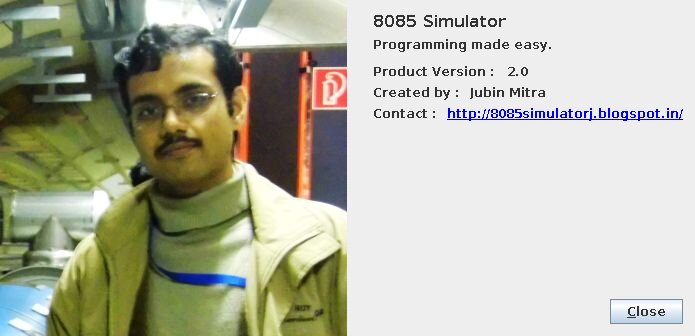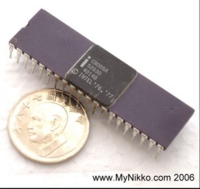Jubin Mitra’s 8085 Simulator¶
This is a Java based program so will run on all OSes.
Simulator Download¶
download Jubin Mitra's 8085 Simulator
To Run On Linux/BSD¶
java -jar 8085Compiler.jar
To Run On Windows¶
- Make sure you have Java installed on your system. Check this by typing java -version into the command terminal. If you don’t have the latest version of Java, update it before proceeding.
- Install Java (ver >6) http://www.java.com/en/download/manual.jsp
- Just double click the “.jar ” file, it should execute.
- Otherwise you can execute in CMD ( Command Prompt ) by typing ” java -jar 8085Compiler.jar “
Jubin Mitra’s 8085 Simulator Web Site¶
8085 Virtual Development Board¶
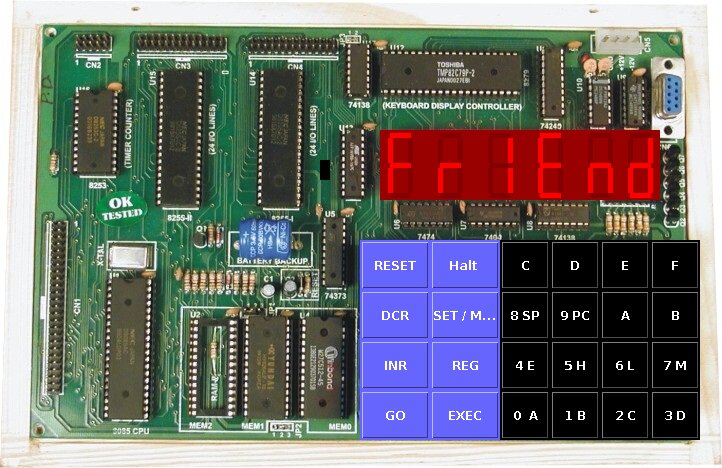
8085 IDE Pic 1¶
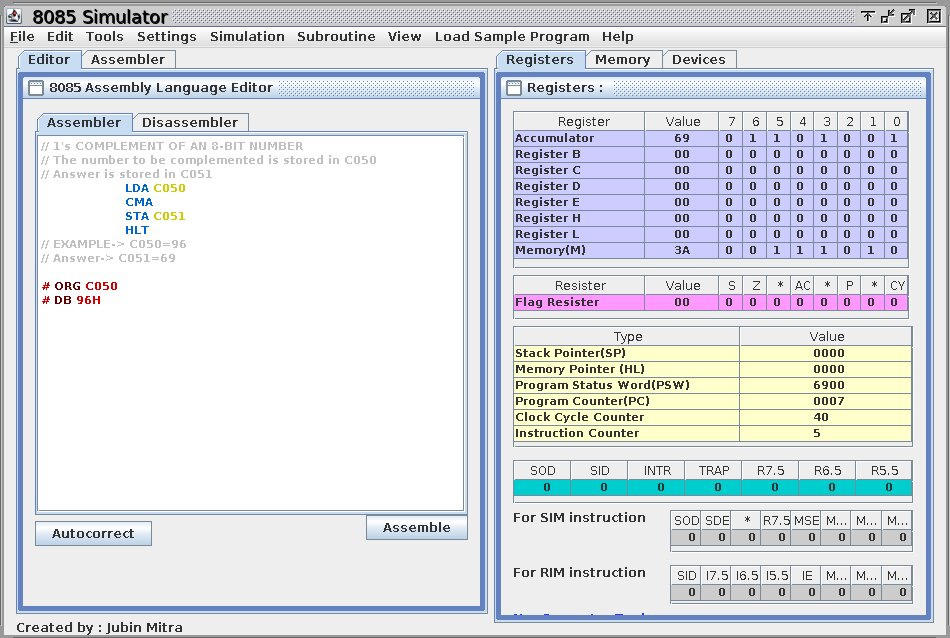
8085 IDE Pic 2¶
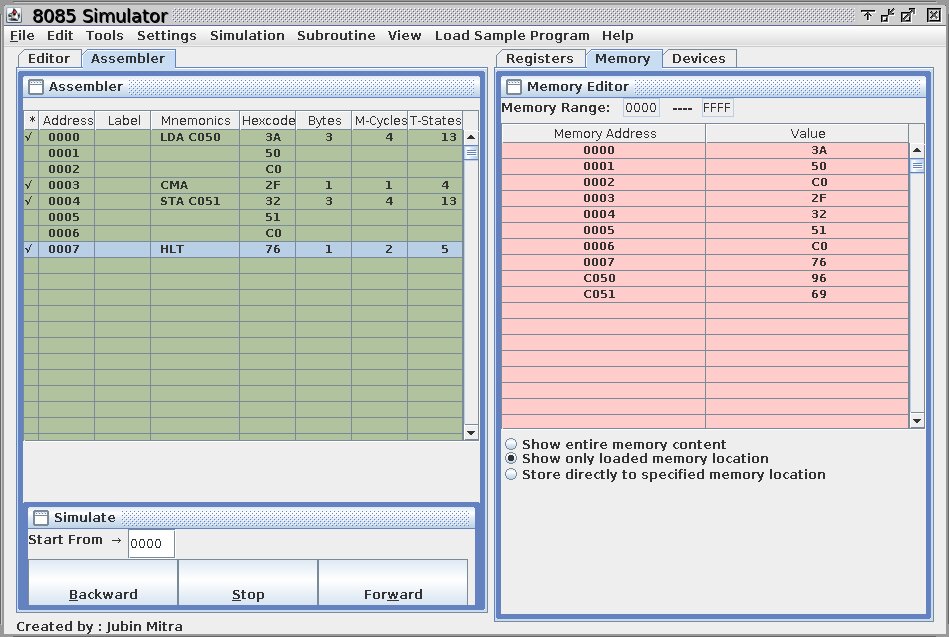
8085 Code Wizard¶
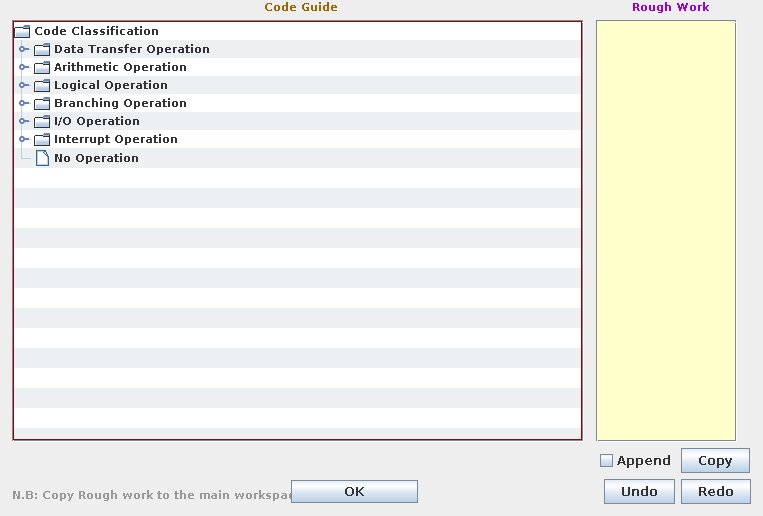
8085 Instruction Set¶
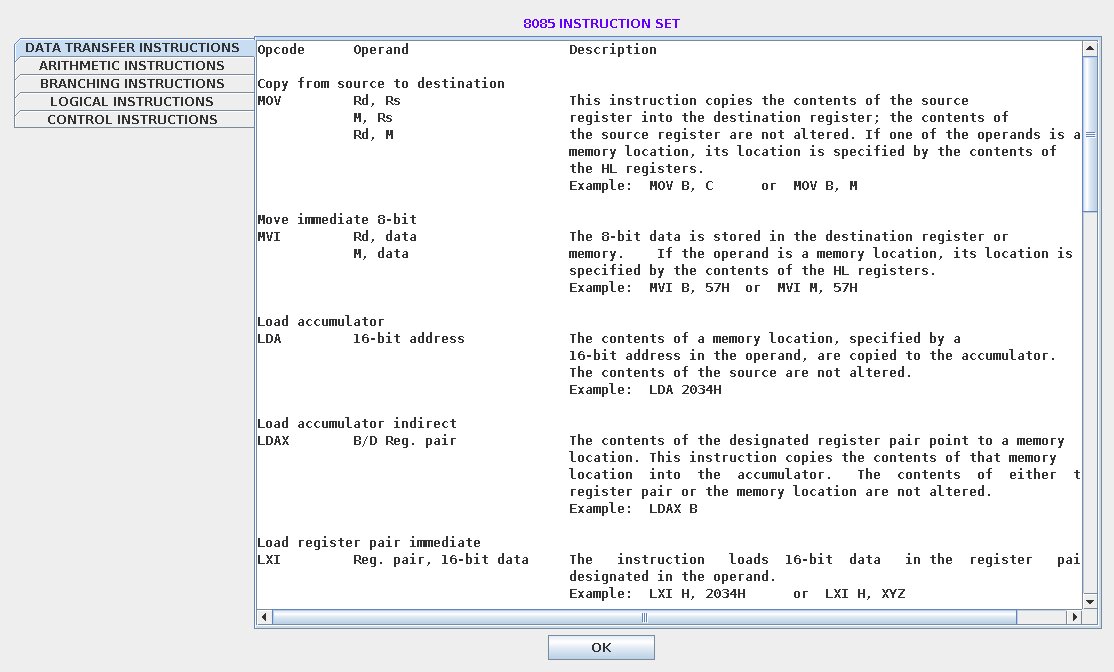
Features¶
- Assembler Editor – Can load Programs written in other simulator – Auto-correct and auto-indent features – Supports assembler directives – Number parameters can be given in binary, decimal and hexadecimal format – Supports writing of comments – Supports labeling of instructions, even in macros – Has error checking facility – Syntax Highlighting
- Disassembler Editor – Supports loading of Intel specific hex file format – It can successfully reverse trace the original program from the assembly code, in most of the cases – Syntax Highlighting and Auto Spacing
- Assembler Workspace – Contains the Address field, Label, Mnemonics, Hex-code, Mnemonic Size, M-Cycles and T-states – Static Timing diagram of all instruction sets are supported – Dynamic Timing diagram during step by step simulation – It has error checking facility also
- Memory Editor – Can directly update data in a specified memory location – It has 3 types of interface, user can choose from it according to his need. – Show entire memory content – Show only loaded memory location – Store directly to specified memory location – Allows user to choose memory range
- I/O Editor – It is necessary for peripheral interfacing. – Enables direct editing of content
- Interrupt Editor – All possible interrupts are supported. Interrupts are triggered by pressing the appropriate column (INTR, TRAP, RST 7.5, RST 6.5, RST 5.5) on the interrupt table. The simulation can be reset any time by pressing the clear memory in the settings tab.
- Debugger – Support of breakpoints – Step by step execution/debugging of program. – It supports both forward and backward traversal of programs. – Allows continuation of program from the break-point.
- Simulator – There are 3 level of speed for simulation: – Step-by-step : Automatic line by line execution with each line highlighting. The time to halt at each line is be decided by the user. – Normal : Full execution with reflecting intermittent states periodically. – Ultimate : Full execution with reflecting final state directly. – There are 2 modes of simulator engine: – Run all at a Time : It takes the current settings from the simulation speed level and starts execution accordingly. – Step by Step : It is manual mode of control of FORWARD and BACKWARD traversal of instruction set. It also displays the in-line comment if available for currently executed instruction. – Allows setting of starting address for the simulator – Users can choose the mnemonic where program execution should terminate
- Helper – Help on the mnemonics is integrated – CODE WIZARD is a tool added to enable users with very little knowledge of assembly code could also 8085 assembly programs. – Already loaded with plenty SAMPLE programs – Dynamic loading of user code if placed in user_code folder – It also includes a user manual
- Printing – Assembler Content – Workspace Content – Register Bank –> Each register content is accompanied with its equivalent binary value* – Accumulator, Reg B, Reg C, Reg D, Reg E, Reg H, Reg L, Memory (M) – Flag Register – Stack Pointer (SP) – Memory Pointer (HL) – Program Status Word (PSW) – Program Counter (PC) – Clock Cycle Counter – Instruction Counter – Special blocks for monitoring Flag register and the usage of SIM and RIM instruction
- Crash Recovery – Can recover programs lost due to sudden shutdown or crash of application
- 8085 TRAINER KIT – It simulates the kit as if the user is working in the lab. It basically uses the same simulation engine at the back-end
- TOOLS – Insert DELAY Subroutine TOOL –> It is a powerful wizard to generate delay subroutine with user defined delay using any sets of register for a particular operating frequency of 8085 microprocessor. – Interrupt Service Subroutine TOOL –> It is a handy way to set memory values at corresponding vector interrupt address – Number Conversion Tool –> It is a portable interconversion tool for Hexadecimal, decimal and binary numbers. So, that user do not need to open separate calculator for it.
8085 Simulator Creator and Credits¶
